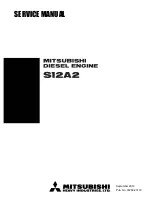
G424 Service Manual
LPG Fuel System(Low Emission Version)
89
LP Carburetor
(Variable Venturi)
The variable venturi air/fuel mixer is mounted in the
intake air stream between the air cleaner and the
intake manifold. The design of the main section
incorporates a cylindrical bore through the center (1)
and a gas discharge jet (2). Incorporated into the inlet
of the mixer bore is the air valve (3), tapered gas
metering valve (4), air valve diaphragm (5) and
calibrated air valve metering spring (6). The gas valve
(4) is permanently attached to the air valve (3) with a
face seal mounted in between the two parts (the air-
gas valve assembly is mounted in the center of and
supported by the diaphragm). When the engine is not
running this face seal creates a gas tight seal against
the gas discharge jet (2), with the downward force of
the calibrated air valve spring (6). A throttle valve (7) is
incorporated into the carburetor assembly.
1. Mixer bore
2. Gas discharge jet
3. Air valve
4. Gas valve
5. Air valve diaphragm
6. Air valve spring
7. Throttle valve
8. Air valve vacuum chamber
9. Vacuum transfer ports
10. Atmospheric pressure
11. Fixed main mixture jet
12. Vacuum port
13. Vacuum switch (MAP)
14. Vacuum switch
As the engine is started it begins to draw in air. Since
the air valve (3) is covering the inlet to the mixer bore
a negative pressure begins to build. This negative
pressure signal is communicated to the air valve
vacuum chamber (8) through four vacuum transfer
ports (9) in the air valve (3). A pressure / force
imbalance begins to build across the air valve
diaphragm (5) between the air valve vacuum chamber
(8) and atmospheric pressure below the diaphragm
(10).
As the negative pressure in the air valve vacuum
chamber (8) reaches setting value of water column the
air valve (3) begins to lift against the pressure of the
calibrated air valve metering spring (6) .The amount of
negative pressure generated is a direct result of
throttle position and the amount of air flowing through
the mixer into the engine. As the air valve (3) rises it
lifts the tapered gas metering valve (4) off its seat and
exposes the gas discharge jet (2) to the negative
pressure signal generated within the mixer bore.
This allows the negative pressure signal to travel to
the secondary vacuum chamber of the pressure
regulator and operate the regulator. I he profile of the
tapered gas valve (4), in conjunction with the regulator
spring, meters out the desired A/F ratio.
A/F mixture at idle is adjusted with a tapered idle
screw (not shown) which is capped at production and
cannot be adjusted. A/F ratio at maximum load is
limited by the fixed main mixture jet (11), which is
sized for the application.
In addition the assembly includes two manifold
sensors, one for switching the ECU control (13)
depending on engine load, and the other for operating
a lock-off solenoid (14). In addition the unit is fitted
with a precisely controlled vacuum port (12) to allow
control of ignition timing by vacuum load control.
14
13
11
2
10
3
9
6
8
5
4
1
12
7
Содержание G424 Gasoline
Страница 24: ...G424 Service Manual Engine System 23 Gasoline Engine ...
Страница 25: ...G424 Service Manual Engine System 24 LPG Engine Low Emission Version ...
Страница 30: ...G424 Service Manual Engine System 29 LPG Engine Low Emission Version ...
Страница 32: ...G424 Service Manual Engine System 31 Wiring Diagram LPG Engine Low Emission Version ...
















































